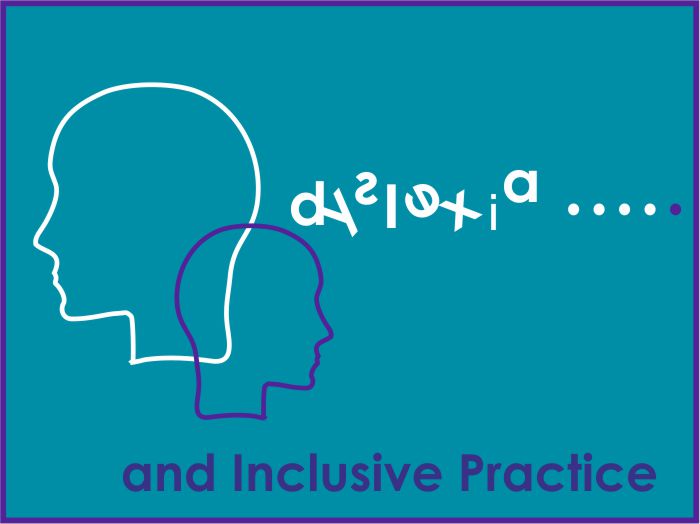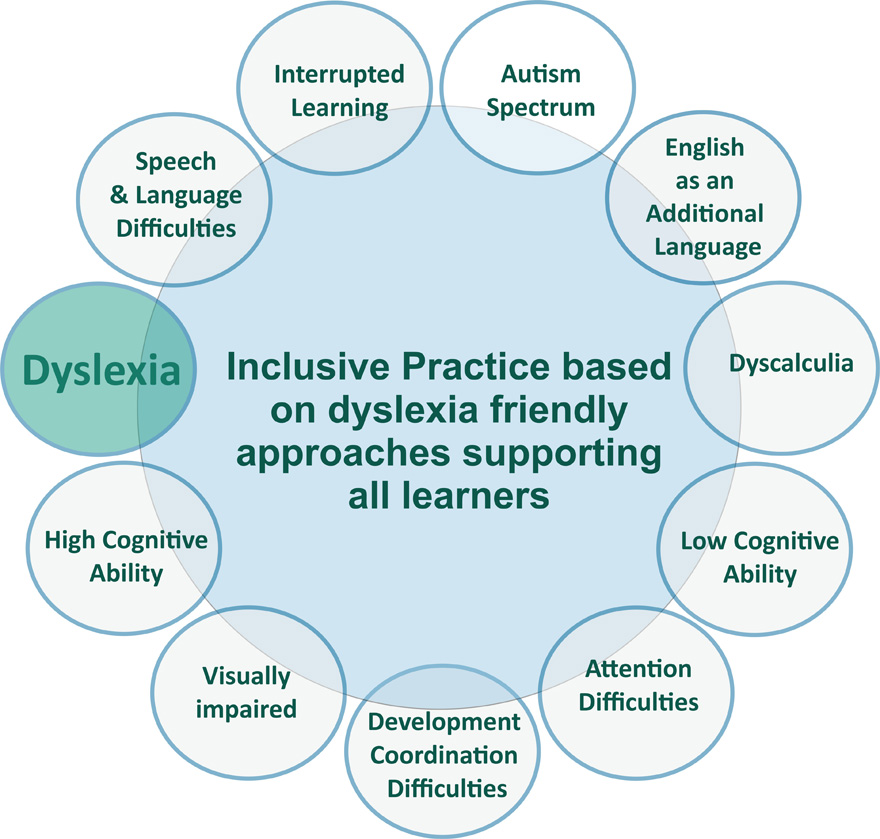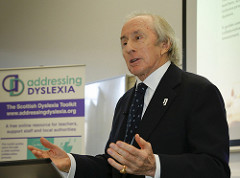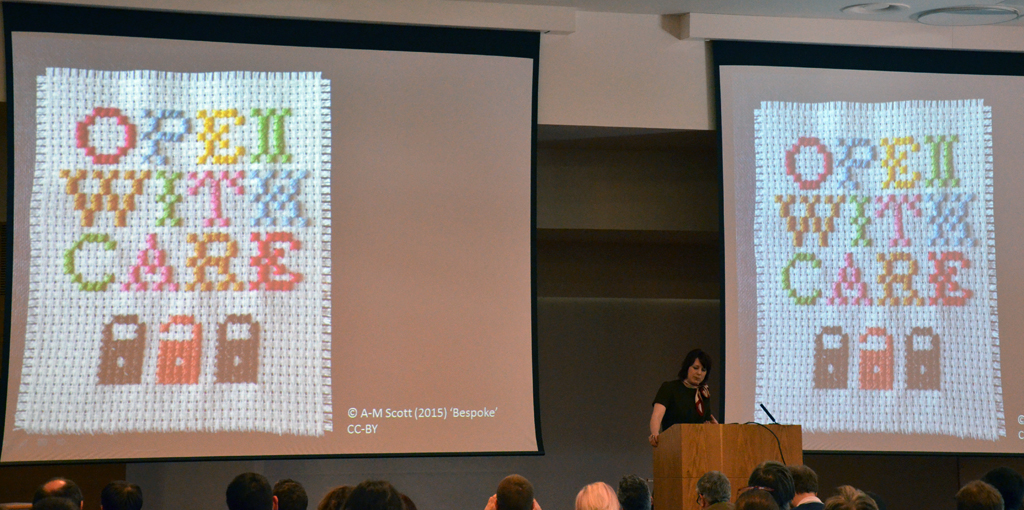The courses are aimed at practitioners and educators alike and enable participants to understand and identify dyslexia. They have also been developed specifically with the Scottish context in mind. As Fran Ranaldi, Development Officer at Education Scotland who developed and lead authored Introduction to Dyslexia and Inclusive Practice explained:
“…there was a lack of high quality free training available within the Scottish context for practitioners to find out more about dyslexia and become very confident and comfortable with the identification process. We have a very different system in Scotland as it exists in England. It’s important to understand, in England you have a qualification to identify dyslexia. In Scotland you do not within the school system.
We wanted to create a course that would help practitioners stretch and challenge themselves and learn a lot more about it, but wouldn’t have the cost implications that an accredited course currently has because, as I’ve mentioned, it’s not needed within a Scottish context because we’re a needs-led system, we’re not a label based system.”
Introduction to Dyslexia and Inclusive Practice requires no financial outlay by the user or their employer and was developed in line with the General Teaching Council of Scotland (GTCS) professional standards. The course is openly licensed and as Fran explains this is an important feature of the course, which is already making an impact:
“We’ve got 32 different local authorities, education and children services and it’s about working with them to hopefully help them reduce the reinvention of the wheel because in an ideal world, they wouldn’t want to go and make a course. They would just use the one that we’ve created.
If they don’t want to do anything else, they could use the materials that are there, even the diagrams and the graphics. They could use that. Indeed, that’s already happening. I’ve got a colleague. He’s doing …a one-day course. They’re going to use some of the graphics that we’ve got.”
Not only can Introduction to Dyslexia and Inclusive Practice be easily accessed and reused but as it is openly licensed it can also be repurposed for use within different contexts and be updated easily to reflect policy and practice changes and to create new versions of the content, depending on user requirements.
Tools of the Trade: The Origins of Introduction…
The Making Sense Working Group (MSWG) was set up in response to the 2014 Making Sense Review; the Review itself was commissioned by the Scottish Government following a request by Dyslexia Scotland that an earlier 2008 HMIE review on dyslexia be revisited. The working group aimed to bring together a range of stakeholders to address 2014 Education Scotland recommendations to develop and support educators’ understanding and identification of dyslexia. Stakeholders include Dyslexia Scotland, local authorities, Scottish Teacher Education Committee (STEC) and the Association of Educational Psychologists in Scotland (ASPEP) (full list). In 2010 the Assessing Dyslexia toolkit was launched. In 2012 a further iteration of the toolkit was launched: Addressing Dyslexia.
Introduction… was developed by the MSWG as part of their response to recommendations made by the 2014’s Making Sense Review and the Scottish Government’s response:
- “Teachers, support staff, learners and parents should have access to up-to-date practical advice and guidance on dyslexia;
- Teachers, support staff and local authority staff should have access to a wide range of high quality career-long professional learning opportunities at school, local and national level related to meeting the needs of children and young people with dyslexia;
- Initial teacher education and postgraduate awards and courses should give a high priority to developing knowledge and skills in relation to dyslexia and additional support needs;
- Schools, local authorities and national partners should take action to improve the quality of educational outcomes for children and young people with dyslexia;
- The availability and use of reliable information on children and young people’s needs, development and achievement should be improved.” (REF)
Introduction… was based around the Toolkit, rather than a further iteration of the Toolkit itself, and represented an important next step in supporting teachers in Scotland. As Cathy Magee, CEO of Dyslexia Scotland explained:
“…We knew that teachers were going to England to do a lot of courses on dyslexia and that the universities in Scotland had not in recent years done any specific courses on this so we knew there was a gap. But we also knew that teachers were telling us they couldn’t afford the time and the money to be able to actually pay for courses themselves…”
In addition to the real need for teachers at all stages of their career to be informed, the opportunity to make the Toolkit’s materials “more accessible” and easier to navigate through the open course format and provide an open badge for participation were also important:
“…the fact that it’s Open University badged as well has helped us get around some of the concerns that people were having about, is this an accredited course, we wanted it to be linked into professional learning and GTCS registration because that’s a requirement for all teachers…”
The Rapid Development of Introduction…
An off-chance meeting with members of the Opening Educational Practices in Scotland (OEPS) project around the time the Making Sense Working Group were considering developing online resources around the Toolkit was central to the collaborative development of Introduction to Dyslexia and Inclusive Practice.Moreover OEPS had already been collaborating with third sector organisations and NGOs to develop open courses. However, whereas previously development had followed The Open University’s standard development schedule of around 6-8 months, Introduction to Dyslexia and Inclusive Practice needed to be developed and available in a much tighter timeframe. On 8 March 2017 Deputy First Minister of Scotland, John Swinney, was due to launch the redesigned Addressing Dyslexia Toolkit with Dyslexia Scotland President Sir Jackie Stewart. This high profile launch was a fantastic opportunity to also launch the course. However, this meant that Introduction to Dyslexia and Inclusive Practice needed to be produced in around 10 weeks. How did the teams work together to create it in such a short space of time?
“The key thing that made it work, from our perspective, was Fran because whereas we normally allow four months for writing and reviewing the fact that she was only adapting materials that were already in existence in the Toolkit and the fact that she would work 24/7 to get them done … meant that the content was developed very, very quickly.” (Rosemarie Mcilwhan, Project Manager of OEPS)
The ‘unique’ combination of Fran as the Chair of the Toolkit working group, which enabled the rapid development of course content, and her commitment to working on the material, resulted in content that required little editing and which was at a level of quality which did not need the full number of content review cycles usually required as part of OU course development. In addition, course development was not slowed by rights clearance or the need to search for suitable images that could be used. Fran, as a trained graphic designer, was happy to release images, diagrams and asset descriptions that she created for the course on an open license in addition to being able to locate other suitable resources for the course quickly and easily.
Mapping learning objectives and being clear on a target audience for Introduction… also helped speed up the course creation process. As Fran explained, developing material in alignment with GTCS’s standards had four benefits:
- There was a natural “target audience” and the identification of this audience, and the subsequent design of material afterwards, was good practice from a learning design perspective.
- Material is immediately relevant and the course more likely to be used as it’s aligned with professional standards.
- The standards provide a structure that allows for quicker development of course material or other content.
- Aligning content with GTCS standards at the beginning of the course development process saves time in the long-run as there is no need to rework or try to align material retrospectively.
OU course development follows a set trajectory of working collaboratively to understand who the course is aimed at, what the resource is intending to do, mapping learning objectives and developing a course structure etc. Once the course content is at the first draft state it then undergoes the standard OU module production process where there is an iterative review of drafts and “critical review” by external parties. At the point of a third draft the course then goes into production with an editor and media assistant working to copyedit the course, add it to OpenLearn Create and check the licensing of any assets used.
Again for the development of Introduction to Dyslexia and Inclusive Practice some of the processes usually deployed in course production could be compressed into shorter timescales. For example course editing took place directly in OpenLearn Create. This was possible due to the high quality material from the Toolkit being reworked by Fran for Introduction to Dyslexia and Inclusive Practice. The toolkit itself had already been through a quality assurance process and been reviewed by the Toolkit Working Group (“the experts in this subject”) and therefore contained few errors.
Lessons Learnt from Collaborative Open Course Creation
In discussing the development of Introduction to Dyslexia and Inclusive Practice with the team, a number of lessons learnt were highlighted by Rosemarie, Anna, Cathy and Fran. Central to developing a course like this within a tight timeframe is the ability of the team to communicate clearly and to be innovative and flexible when required. One successful example of problem solving which enabled momentum around the course to build prior to its launch occurred when it became clear that the course would be ready slightly later than John Swinney and Jackie Stewart’s planned launch:
“We then came up with the idea to create a holding course space for [people wanting to enrol], which meant that people could enrol when they heard about it at the event. I think we picked up 82 or 92 enrolments in that interim period in between the time of the launch event and the publication of the course two weeks later.” (Anna Page, Senior Producer, OEPS)
Reworking the Toolkit content for online course delivery also involved both the development of additional content so that course could be effectively badged, and a particular focus on accessibility. As Rosemarie explained:
“Probably the biggest challenge was getting the quiz questions developed. Firstly to reflect the content and make sure that was correct and Fran and various others in the working group did check them. And then secondly to make sure that the questions were accessible because obviously being about dyslexia we wanted to make sure – as we do for all our courses but particularly important for this one – that it was accessible for screen readers, that we weren’t using any techniques that would make it more difficult, particularly for someone with dyslexia, to be able to engage…” (Rosemarie Mcilwhan, Project Manager of OEPS)
As Anna explained, quiz questions ideally need to be developed in tandem with course material, so that a “question bank” is created. This quiz bank can then be drawn on to develop a series of quizzes, which – as in the case of Introduction to Dyslexia and Inclusive Practice - can be used to “break up the content [and] give pause for reflection” whilst also structuring any badging requirements. More generally, as Anna noted, in addition to assessment being accessible, quizzes need to be interactive, meaningful and tied to the overall course learning objectives. In the case of Introduction to Dyslexia and Inclusive Practice assessment also had to make use of the reflective log and be aligned to the General Teaching Council for Scotland framework which was both a “benefit and a challenge” for the course’s development. Ensuring assessment is meaningful requires careful thought. Again, as Anna and Rosemarie explained, when developing quizzes care should be taken to avoid developing “wrong answers” which reinforce stereotypes or are not obvious “distractors.”
Finally, as Rosemarie noted “any resource is only as good as those who know about it” and collaboratively creating content needs to factor in creative and mid-long term promotion of that content across a range of platforms accordingly. As seen above, pre-registration for Introduction to Dyslexia and Inclusive Practice had a massive impact, for example, so looking for opportunities to promote the course whilst in development and in novel ways should not be overlooked. Similarly, considering how you will measure the impact of a course (through analytics and surveys, for example) are essential for finding out what users think, how the course is being used and where improvements could be made.
Originally published on 7 August 2017 - 10:11am by Beck Pitt
Further Reading
- Making Sense – Update (November 2016)
Image credits: Dyslexia...and inclusive practice (course logo) and Dyslexia diagram (from section 3.2) are both CC BY-NC-SA, Dyslexia Support Funding Doubles by Scottish Government is licensed CC BY-NC, Dyslexia Support Funding Doubles (group photo) by Scottish Government is licensed CC BY-NC and Open Window by oatsy40 is licensed CC BY 2.0







